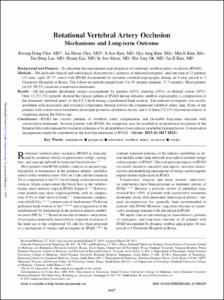Rotational Vertebral Artery Occlusion Mechanisms and Long-term Outcome
- Affiliated Author(s)
- 이형
- Alternative Author(s)
- Lee, Hyung
- Journal Title
- Stroke
- ISSN
- 0039-2499
- Issued Date
- 2013
- Abstract
- Background and Purpose: To elucidate the mechanisms and prognosis of rotational vertebral artery occlusion (RVAO).
Methods: We analyzed clinical and radiological characteristics, patterns of induced nystagmus, and outcome in 21 patients (13 men, aged 29–77 years) with RVAO documented by dynamic cerebral angiography during an 8-year period at 3 University Hospitals in Korea. The follow-up periods ranged from 5 to 91 months (median, 37.5 months). Most patients (n=19; 90.5%) received conservative treatments.
Results: All the patients developed vertigo accompanied by tinnitus (38%), fainting (24%), or blurred vision (19%). Only 12 (57.1%) patients showed the typical pattern of RVAO during dynamic cerebral angiography, a compression of the dominant vertebral artery at the C1-2 level during contralateral head rotation. The induced nystagmus was mostly downbeat with horizontal and torsional components beating toward the compressed vertebral artery side. None of the patients with conservative treatments developed posterior circulation stroke, and 4 of them (21.1%) showed resolution of symptoms during the follow-ups.
Conclusions: RVAO has various patterns of vertebral artery compression, and favorable long-term outcome with conservative treatments. In most patients with RVAO, the symptoms may be ascribed to asymmetrical excitation of the bilateral labyrinth induced by transient ischemia or by disinhibition from inferior cerebellar hypoperfusion. Conservative management might be considered as the first-line treatment of RVAO.
- Department
- Dept. of Neurology (신경과학)
- Publisher
- School of Medicine
- Citation
- Kwang-Dong Choi et al. (2013). Rotational Vertebral Artery Occlusion Mechanisms and Long-term Outcome. Stroke, 44(7), 1817–1824. doi: 10.1161/STROKEAHA.113.001219
- Type
- Article
- ISSN
- 0039-2499
- Appears in Collections:
- 1. School of Medicine (의과대학) > Dept. of Neurology (신경과학)
- 파일 목록
-
-
Download
 oak-aaa-4369.pdf
기타 데이터 / 1.62 MB / Adobe PDF
oak-aaa-4369.pdf
기타 데이터 / 1.62 MB / Adobe PDF
-
Items in Repository are protected by copyright, with all rights reserved, unless otherwise indicated.